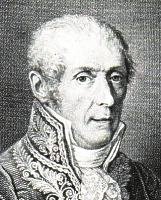Online Encyclopedia
Alessandro Volta
Alessandro Giuseppe Antonio Anastasio Volta (February 18, 1745 - March 5, 1827) was an Italian physicist known especially for the development of the electric battery. Late in life, he received the title of Count.
Biography
Volta was born and educated in Como, Italy, where he became professor of physics at the Royal School in 1774. His passion had always been the study of electricity, and still a young student he had even written a poem in Latin on this fascinating new discovery.De vi attractiva ignis electrici ac phaenomenis inde pendentibus is his first scientific paper.
In 1775 he devised the electrophorus, a device that produced a static electric charge. In 1776-77 he studied the chemistry of gases, discovered methane, and devised experiments such as the ignition of gases by an electric spark in a closed vessel. In 1779 he became professor of physics at the University of Pavia, a chair he occupied for 25 years. In 1794 Volta married Teresa Peregrini, daughter of Count Ludovico Peregrini; the couple had three sons.
In 1800, as the result of a professional disagreement over the galvanic response advocated by Luigi Galvani, he developed the so-called voltaic pile, a forerunner of the electric battery, which produced a steady electric current. Volta had determined that the most effective pair of dissimilar metals to produce electricity was zinc and silver. Initially he experimented with individual cells in series, each cell being a wine goblet filled with brine into which the two dissimilar electrodes were dipped. The electric pile replaced the goblets with cardboard soaked in brine. (The number of cells, and thus the voltage it could produce, was limited by the pressure, exerted by the upper cells, that would squeeze all of the brine out of the cardboard of the bottom cell.)
Honors
In honor of his work in the field of electricity, Napoleon made him a count in 1810; in 1815 the Emperor of Austria named him a professor of philosophy at Padua. Volta is buried in the city of Como in Italy; the Tempio Voltiano near Lake Como is a museum devoted to explaining his work; his original instruments and papers are on display there. The building appeared, along with his portrait, on Italian currency before the introduction of the Euro.
In 1881 an important electrical unit, the volt, was named in his honor. Volta is on 10000-Lira note.



